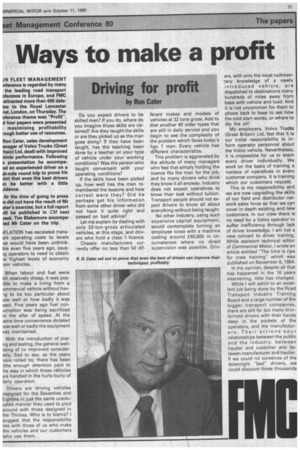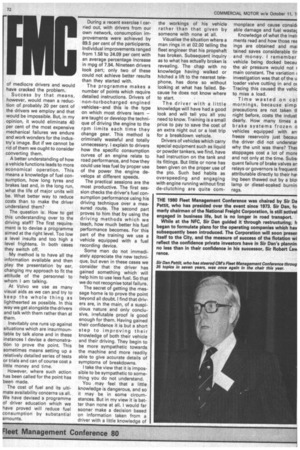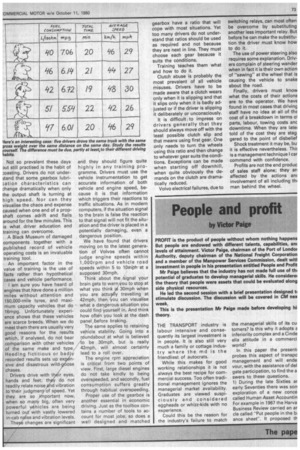Ways to make a profit
Page 73

Page 74

Page 75

If you've noticed an error in this article please click here to report it so we can fix it.
Driving for profit
by Ron Cater
JR FLEET MANAGEMENT ,nference is regarded by many the leading road transport nference in Europe, and FMC attracted more than 400 deletes to the Royal Lancaster rtel, London, on Thursday. The nference theme was "Profit", d four papers were presented I maximising profitability rough better use of resources.
Ron Cater, sales development anager of Volvo Trucks (Great itain) Ltd, dealt with improved ihicle performance. Following s presentation he accompaed an experienced driver on a i0-mile round trip to prove his )int that even the best drivers in be better with a little Jidance.
At the time of going to press re did not have the result of Mr ater's exercise, but a full report rill be published in CM next reek. Tim Blakemore accompaied Mr Cater on the trip.
JFLATION has escalated transort operating costs to levels at would have been unthinkble even five years ago, causig operators to need to obtain le highest levels of economy -om vehicles.
When labour and fuel were till relatively cheap, it was posible to make a living from a ommercial vehicle without havig to be too particular about low well or how badly it was ised. Five years ago fuel con;umption was being sacrificed )n the altar of speed. At the ;ame time convenience dictated low well or badly the equipment vas maintained.
With the introduction of platng and testing, the general well)eing of cv improved considerthly. Sad to say, as the years lave rolled by, there has been ittle enough attention paid to :he way in which those vehicles 3 re handled in the hurly-burly of daily operation.
Drivers are driving vehicles designed for the Seventies and Eighties in just the same uneducated manner they used to plod around with those designed in the Thirties. Who is to blame? I suggest that the responsibility lies with those of us who make the vehicles and our customers who use them. Do you expect drivers to be skilled men? If you do, where do you imagine those skills are obtained? Are they taught the skills or are they picked up as the man goes along? If they have been taught, has the teaching been done by a teacher on your type of vehicle under your working conditions? Was the person who taught conversant with your operating conditions?
If the skills have been picked up, how well has the man remembered the lessons and how correct were they? Did he perhaps get his information from some other driver who did not have it quite right and passed on bad advice?
Let me explain by dealing with only 32-ton-gross articulated vehicles, at this stage, and drivers who hold a class 1 licence.
Chassis manufacturers currently offer no less than 50 dif
ferent makes and models of vehicles at 32 tons gross. Add to that another 40 older types that are still in daily service and you begin to see the complexity of the problem which faces today's hgv 1 man. Every vehicle has different characteristics.
This problem is aggravated by the attitude of many managers who feel that simply holding the licence fits the man for the job, and by many drivers who think they know it all anyway. Industry does not expect operatives to know their task without tuition. Transport people should not expect drivers to know all about everything without being taught.
No other industry, using such expensive capital equipment, would contemplate turning an employee loose with a machine costing around £40,000 in circumstances where no direct supervision was possible. Driv
ers, with only the most rudimentary knowledge of a newly introduced vehicle, are dispatched to destinations many hundreds of miles away from base with vehicle and load. And it is not uncommon for them to phone back to base to ask how the cold start works, or where to dip the oil!
My employers, Volvo Trucks (Great Britain) Ltd, feel that it is our initial responsibility to inform operator personnel about the Volvo vehicle. Nevertheless, it is impossible for us to teach every driver individually. We work on the basis of training a nucleus of operatives in every customer company. It is training which our customers request.
This is my responsibility and we are now upgrading the skills of our field and distributor network sales farce so that we can cover in depth existing and new customers. In our view there is no need for a Volvo operator to suffer inefficiency through lack of driver knowledge. I am not a new convert to driver training. While assistant technical editor of Commercial Motor, I wrote an article entitled "The time is ripe for crew training" which was published on November 6, 1964.
In my opinion, despite all that has happened in the 16 years intervening, little has changed.
While I will admit to an excellent job being done by the Road Transport Industry Training Board and a large number of the bigger transport companies, there are still far too many ill-informed drivers with their hands deep in the pockets of the operators, and the manufacture rs . Their actions sour relationships between the public and the industry, between haulier and customer and between manufacturer and haulier. If we could rid ourselves of the downright "baddrivers, we could discount those thousands
of mediocre drivers and would have cracked the problem.
Success by that means, however, would mean a reduction of probably 20 per cent of the drivers we employ and that would be impossible. But, in my opinion, it would eliminate 40 per cent of the most expensive mechanical failures we endure and work wonders for the industry's image. But if we cannot be rid of them we ought to consider converting them.
A better understanding of how a vehicle functions leads to more economical operation. This means a knowledge of fuel consumption, how long tyres and brakes last and, in the long run, what the life of major units will be. What better way to reduce costs than to make the driver understand them?
The question is: How to get this understanding over to the driving staff? The first requirement is to devise a programme aimed at the right level. Too low a level insults and too high a level frightens. In both cases they switch off.
My method is to have all the information available and then play the presentation by ear, changing my approach to fit the attitude of the personnel to whom I am talking.
At Volvo we use as many visual aids as we can and try to keep the whole thing as lighthearted as possible. In this way we get alongside the drivers and talk with them rather than at them.
Inevitably one runs up against situations which are insurmountable by talk alone and in these instances I devise a demonstration to prove the point. This sometimes means setting up a relatively detailed series of tests or trials and can of course cost a little money and time.
However, where such action has been called for the point has been made.
The cost of fuel and its ultimate availability concerns us all. We have devised a programme of driver education which we have proved will reduce fuel consumption by substantial amounts. During a recent exercise I carried out, with drivers from our own network, consumption improvements were achieved by 89.5 per cent of the participants. Individual improvements ranged from 1.58 to 24.09 per cent with an average percentage increase in mpg of 7.94. Nineteen drivers took part; only two of these could not achieve better results than they started with.
The programme makes a number of points which require detailed instructions. Drivers of non-turbocharged engined vehicles—and this is the type on which most drivers learn — are taught or develop the technique of driving the engine to the rpm limits each time they change gear. This method is criminally wasteful and totally unnecessary. I explain to drivers how the specific consumption curves of an engine relate to road performance, and how they could use less fuel by proper use of the power the engine develops at different speeds.
The practical sessions are the most productive. The first session checks the driver's fuel consumption performance using his driving technique over a measured route. The second part proves to him that by using the driving methods which we teach, how much better his fuel performance becomes. For this part of the training we use a vehicle equipped with a fuel recording device.
Some men do not immediately appreciate the new technique, but even in these cases we consider that the driver has gained something which will help him to use less fuel. So that we do not recognise total failure, The secret of getting the message home is to prove the point beyond all doubt. I find that drivers are, in the main, of a suspicious nature and only conclusive, irrefutable proof is good enough for them. Having gained their confidence it is but a short step to improving their knowledge of both their vehicle and their driving. They begin to be more sympathetic towards the machine and more readily able to give accurate details of symptoms of breakdowns.
I take the view that it is impossible to be sympathetic to something you do not understand.
You may feel that a little knowledge is dangerous, and so it may be in some circumstances. But in my view it is better than none at all. I would far sooner make a decision based on information taken from a driver with a little knowledge of the workings of his vehicle rather than that given by someone with none at all.
Visualise the situation where a man rings in at 02.00 telling the fleet engineer that his propshaft has broken. Subsequent inquiry as to what has actually broken is revealing. The chap with no knowledge having walked or hitched a lift to the nearest telephone, has done so without looking at what has failed. Because he does not know where to start.
The driver with a little knowledge will have had a good look and will tell you all you need to know. Training is a small price to pay to save the cost of an extra night out or a lost trip for a breakdown vehicle.
Drivers of vehicles which carry special equipment such as liquid or powder tankers, we find, have had instruction on the tank and its fittings. But little or none has been given on the proper use of the pto. Such bad habits as overspeeding and engaging with engine running without first de-clutching are quite com
monplace and cause considi able damage and fuel wastac Knowledge of what the instt ments read and how those rea ings are obtained and mai tamed saves considerable tin and money. I remember vehicle being docked becau the air pressure would not r main constant. The variation r investigation was that of the u loader valve cutting in and ot Tracing this caused the vehic to miss a load.
Time wasted on col mornings, because simp precautions are not taken tt night before, costs the indust dearly. How many times a brake systems frozen o vehicles equipped with an: freeze reservoirs just becaw the driver did not understar why the unit was there? The stoppages cost a lot of monE and not only at the time. Subsi quent failure of brake valves an relays or governors is frequent attributable directly to their hal ing been thawed out by a bloi lamp or diesel-soaked burnin rags. Not so prevalent these days put still practised is the habit of .7.oasting. Drivers do not understand that some gearbox lubriati on characteristics can change dramatically when only the output shaft is turning at high speed. Nor can they visualise the chaos and expense caused when one end of a prop shaft comes adrift and flails around for the few minutes. This is what driver education and training can overcome.
A Black Museum of damaged components together with a published record of vehicle operating costs is an invaluable training tool.
An important factor in the value of training is the use of facts rather than hypothetical cases and vehicle performance. I am sure you have heard of engines that have done a million miles without attention and 150,000-mile tyres, and maximum capacity vehicles that do 16rnpg. Unfortunately experi ence shows that these vehicles are scarce breeds. When we do meet them there are usually very good reasons for the results which, if analysed, do not bear comparison with other vehicles of the same make and type„ Heeding fictitious or bad }y recorded results sets up ex n sive and disastrous wild-a6ose chases.
Drivers drive with t 7ir eyes,
hands and feet; th do not readily relate noise nd vibration to their judgmen of speed. Yet they are so iportant now, when so many big, often very powerful vehicles are being turned ou,t" with vastly lowered
in-cab nplise and vibration levels. These changes are significant
and they should figure quite highly in any training programme. Drivers must use the vehicle instrumentation to get accurate information of both vehicle and engine speed, because it is that information which triggers their reactions to traffic situations. As in modern computers, if the situation signal to the brain is false the reaction to that signal will not fit the situation and the driver is placed in a potentially damaging, even a dangerous position.
We have found that drivers moving on to the latest generation of Volvos often cannot judge engine speeds within 1,000rpm and vehicle road speeds within 5 to 10rnOr at a supposed 30mph.
Think about the/signal your brain gets to warnAiou to stop at what you think 30mph when you are actu y travelling at 42mph, then you can visualise what a dangerous situation you could find yourself in. And think how often you look at the dash panel before braking.
The same applies to retaining vehicle stability. Going into a coundabout at what is believed /to be 30mph, but is really 42mph, will almost certainly lead to a roll over.
The engine rpm appreciation is critical from two points of view. First, large diesel engines do not take kindly to being overspeeded, and secondly, fuel consumption suffers greatly through habitual overspeeding.
Proper use of the gearbox is another essential in economic driving. Just as the toolbox contains a number of tools to account for most jobs, so does a well designed and matched gearbox have a ratio that will cope with most situations. Yet too many drivers do not understand that ratios should be used as required and not because they are next in line. They must choose each gear because it suits the conditions.
Training teaches them what and how to do it.
Clutch abuse is probably the most prevalent of all vehicle misuses. Drivers have to be made aware that a clutch wears only when it is slipping and that it slips only when it is badly adjusted or if the driver is slipping it deliberately or unconsciously.
It is difficult to impress on drivers generally that they should always move off with the least possible clutch slip and that means using first gear. One only needs to turn the wheels using this ratio and then change to whatever gear suits the conditions. Exceptions can be made when starting off downhill, when quite obviously the demands on the clutch are dramatically reduced.
Volvo electrical failures, due to THE TRANSPORT industry is labour intensive and consequently its largest investment is in people. It is also still very much a family or cottage industry where the md is the friendliest of autocrats.
While this makes for good working relationships it is not always the hest recipe for commercial success. Too often traditional management ignores the managerial market availability. Graduates are viewed suspiciously and considered eggheads or whizz-kids with no experience.
Could this be the reason for the industry's failure to match switching relays, can most often be overcome by substituting another less important relay. But before he can make the substitution the driver must know how to do it.
The use of power steering also requires some explanation. Drivers complain of steering wander when in fact it is their own action of "sawing" at the wheel that is causing the vehicle to snake about the road.
Finally, drivers must know what the costs of their actions are to the operator. We have found in most cases that driving staff have no idea at all of the cost of a breakdown in terms ol parts, labour, towing costs anc downtime. When they are latei told of the cost they are stag gered to the point of disbelief Shock treatment it may be, bu it is effective nevertheless. Thi: is a management technique I car commend with confidence.
Profits are not the end produc of sales staff alone; they an affected by the actions an involvement of all including thi man behind the wheel.
the managerial skills of its cu tomers? Is this why it adopts a inferiority complex and a Cinde ella attitude in a commerci world?
In this paper the present' probes this aspect of transpo management and will ende your, with the assistance of del gate participation, to find the a swers to these questions.
1) During the late Sixties ar early Seventies there was son exploration of a new conce called Human Asset Accountin For example in 1 967 the Harva Business Review carried an ar cle called "Put people in the bi ance sheet". It proposed th












































































































































































